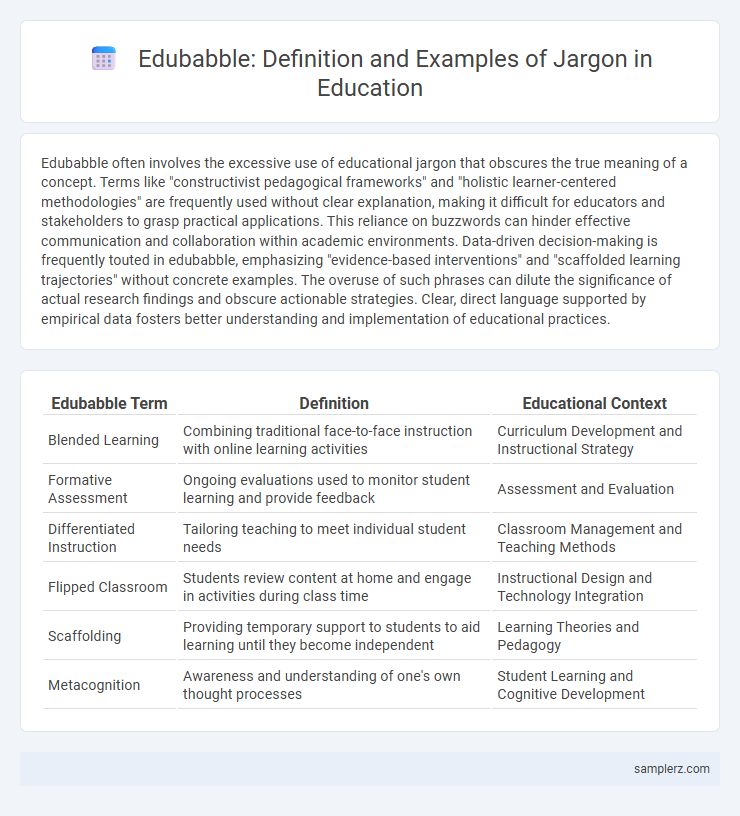Edubabble often involves the excessive use of educational jargon that obscures the true meaning of a concept. Terms like "constructivist pedagogical frameworks" and "holistic learner-centered methodologies" are frequently used without clear explanation, making it difficult for educators and stakeholders to grasp practical applications. This reliance on buzzwords can hinder effective communication and collaboration within academic environments. Data-driven decision-making is frequently touted in edubabble, emphasizing "evidence-based interventions" and "scaffolded learning trajectories" without concrete examples. The overuse of such phrases can dilute the significance of actual research findings and obscure actionable strategies. Clear, direct language supported by empirical data fosters better understanding and implementation of educational practices.
Table of Comparison
| Edubabble Term | Definition | Educational Context |
|---|---|---|
| Blended Learning | Combining traditional face-to-face instruction with online learning activities | Curriculum Development and Instructional Strategy |
| Formative Assessment | Ongoing evaluations used to monitor student learning and provide feedback | Assessment and Evaluation |
| Differentiated Instruction | Tailoring teaching to meet individual student needs | Classroom Management and Teaching Methods |
| Flipped Classroom | Students review content at home and engage in activities during class time | Instructional Design and Technology Integration |
| Scaffolding | Providing temporary support to students to aid learning until they become independent | Learning Theories and Pedagogy |
| Metacognition | Awareness and understanding of one's own thought processes | Student Learning and Cognitive Development |
Decoding Edubabble: Understanding Common Jargon in Education
Terms like "scaffolding," "formative assessment," and "differentiated instruction" often dominate educational discussions but can confuse those outside the field. Decoding such edubabble requires recognizing these phrases as strategies designed to support student learning, monitor progress, and tailor teaching methods to diverse needs. Understanding this jargon not only clarifies communication among educators but also empowers parents and stakeholders to engage meaningfully in educational processes.
Top Edubabble Terms Teachers Use (and What They Really Mean)
Teachers often use terms like "scaffolding," which means providing temporary support to help students understand new concepts, and "formative assessment," referring to ongoing evaluations that guide instructional adjustments. "Differentiated instruction" signifies tailoring teaching methods to meet diverse student needs, while "learning modalities" describe various sensory approaches like visual, auditory, or kinesthetic learning. These edubabble terms aim to encapsulate complex educational strategies in concise jargon but can confuse when not clearly explained.
Edubabble Examples That Confuse Parents and Students
Terms like "formative assessment," "scaffolding," and "blended learning" often cause confusion among parents and students due to their unclear, jargon-heavy definitions. Phrases such as "differentiated instruction" and "constructivist pedagogy" are frequently used without practical explanations, making it difficult for non-educators to grasp their actual classroom impact. This edubabble creates barriers to effective communication and parental engagement in the education process.
From "Scaffolding" to "Flipped Classroom": Jargon in Action
Scaffolding" refers to the educational technique where teachers provide successive levels of temporary support to help students achieve deeper understanding, while the "Flipped Classroom" model inverts traditional teaching by delivering instructional content outside of class and using in-person time for interactive activities. These terms exemplify common education jargon that encapsulates complex pedagogical strategies in concise phrases, streamlining communication among educators but often creating barriers for parents and students unfamiliar with the terminology. Understanding such jargon enhances clarity in educational discussions and facilitates effective collaboration between all stakeholders.
How Edubabble Shapes Educational Communication
Edubabble, characterized by excessive jargon and buzzwords like "scaffolding," "21st-century skills," and "blended learning," often clouds clear educational communication. This dense terminology can create barriers between educators, administrators, and parents, hindering effective collaboration and understanding. Simplifying language in educational discourse enhances clarity and fosters more inclusive and productive conversations.
Breaking Down Popular Education Buzzwords
Educational jargon often includes terms like "scaffolding," "flipped classroom," and "differentiated instruction," which can confuse rather than clarify teaching strategies. Breaking down these buzzwords reveals practical approaches: scaffolding means providing successive levels of support to help students master tasks, the flipped classroom reverses traditional learning by delivering content at home and practice in class, and differentiated instruction tailors teaching to individual student needs. Clarifying such terminology enhances understanding and effective implementation in educational settings.
Misunderstandings Caused by Edubabble in Schools
Misunderstandings caused by edubabble in schools often arise when complex jargon like "scaffolding" and "metacognitive strategies" are used without clear explanations, leaving teachers and students confused about their practical application. Such vague terminology can obscure important educational objectives, leading to inconsistent teaching methods and ineffective learning outcomes. Clarifying these terms with straightforward language enhances communication and promotes better instructional practices.
Why Do Educators Use Jargon?
Educators often use jargon such as "scaffolding," "formative assessment," and "differentiated instruction" to streamline communication within professional settings and establish a shared understanding of complex concepts. This specialized language facilitates precise discussion among teachers, administrators, and policymakers, promoting efficiency in curriculum design and instructional strategies. Using jargon also signals expertise and aligns educators with community standards and ongoing professional development frameworks.
Edubabble Versus Plain Language in Teacher-Parent Communication
Teachers often use terms like "scaffolding" and "formative assessment" to describe instructional strategies that support student learning, which can confuse parents unfamiliar with educational jargon. In contrast, plain language frames these concepts as "step-by-step help" and "ongoing progress checks" to foster clear communication and collaborative partnerships. Clear communication improves parent involvement, positively impacting student achievement and engagement.
The Impact of Jargon on Student Learning and Engagement
Excessive use of jargon such as "scaffolding," "flipped classrooms," and "differentiated instruction" often confuses students, hindering comprehension and active participation. This edubabble can create barriers between educators and learners, reducing engagement and motivation by making content less accessible. Clear, straightforward language enhances student understanding and fosters a more inclusive and effective learning environment.

example of edubabble in jargon Infographic
 samplerz.com
samplerz.com